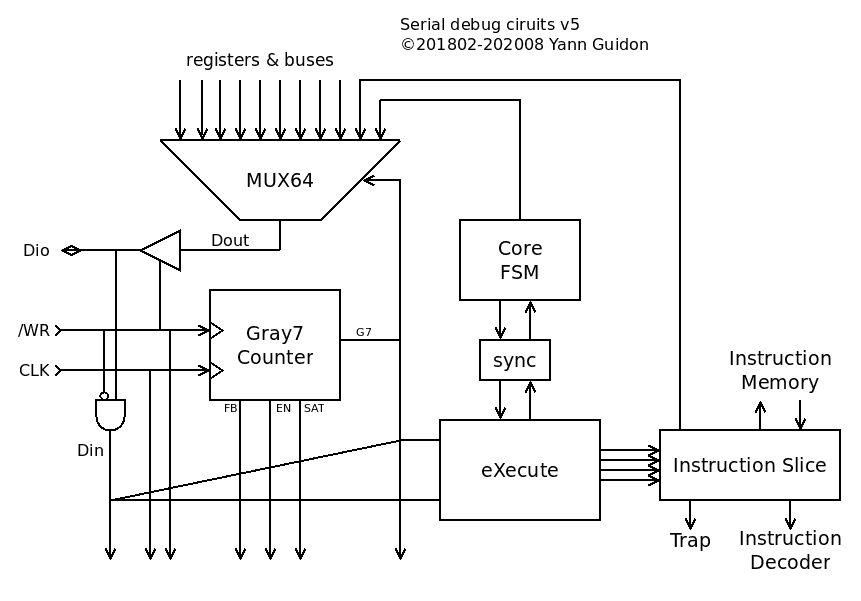The MUX64 is unchanged, the Gray7s circuit is redesigned, the Instruction Slice remains quite the same... The new general diagram shows that we're left with the redesign of the Execute module :

There is one gotcha though, compared to the behaviour of the previous versions :
If you read the MUX beyond the 64 bits, the Gray counter will loop and wrap around in the reverse direction, before going in the forward direction again, and so on...
I might have to reduce the size again because it seeeeeems I might not use the whole counter range. See below.
The timing diagrams have not changed much because the TAP is still driven by the same type of devices (microcontrollers or SBC with a hardwired byte-wide SPI master). So sending a single byte will look like this :

There is a required "little dance" on /WR and CLK after powerup to ensure that the internal state is determined:

Strobe CLK up-down (at least once, could be 8 times), then /WR up-down, and you can read and write as expected (just make sure the serial pin is not driven when /WR is up). Other registers will need to be initialised as well, as there is no real "reset" pin.
There is a significant change on the horizon though. I'd like to use a prefix (byte ?) to also simplify the Selector (it has disappeared on the main diagram). The first byte could be a "short command" to the FSM for example, but for longer messages it also steers the data to the right shift register. Some clock resynch is required for these sub-clocks to prevent a spurious rising edge but I think I found a solution tonight.
Furthermore I have split the first byte into the prefix and the command. This saves some gates because the prefix is latched first, then the command can reuse the same DFF gates. With 3 bits of prefix and 5 bits of command, only 5 bits need to be stored by the new "selector". Furthermore, since decoding logic is shared between the prefix and the command, some further gates could potentially be saved. Then, only 6 units can be selected because prefixes 000 and 111 are reserved (it can reuse the same decoding logic as the previous selector). To save further on gates, each unit will contain its own selector latch and logic.
I like it because that is one internal state fewer to init and/or keep in mind when programming. The command is the state and the system needs fewer cycles to get into a nominal functioning state (and it uses fewer gates). It is less resilient though and the commands must be carefully documented because there is no ASCII mnemonic.
The other benefit is with the timing : the serial interface generates the pulses that were hard to come up with the first version. The /WR pulse can be used to strobe transparent latches, for example.
As a result : most of the commands that were defined so far in 116. TAP summary & protocol will be either 1 or 3 bytes long...
 Yann Guidon / YGDES
Yann Guidon / YGDES
Discussions
Become a Hackaday.io Member
Create an account to leave a comment. Already have an account? Log In.